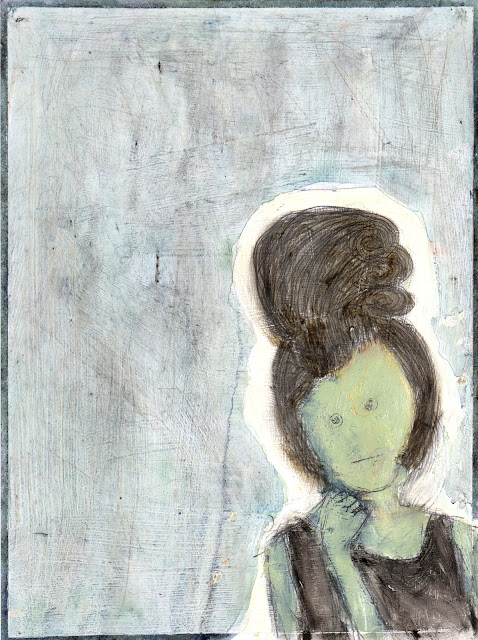 |
| DUTCH SHOES, 27 inches high. Clay, wood, objects, charcoal, graphite |
Melissa Stern is a New York-based artist and writer who is exhibiting work at Firecat Projects in Chicago, in a solo show titled Does She or Doesn't She? The art consists of paintings, drawings, ceramic sculptures and found object assemblages, in all of which we see a common feature: hair. Specifically, a female face or head or form with the hair styled in every imaginable fashion (and probably some beyond imagining). The theme is both playful and serious. Serious, because the idea underpinning the subject matter is the way in which a woman's hair has, since time immemorial, been one of the key ways in which female identity is determined. The title of the show derives from an old advert for hair products, and the unsubtle message that when a woman "fixes" her hair, her personality is completed, which comes with the opposite corollary that "unfixed" hair leads to a socially incomplete woman.
Playful, because the visual style of the pieces, whether in two dimensions or three, is very much immersed in the language of cartoons, graffiti, art brut, the finding of meaning in the loosely drawn and the haphazardly collected. But don't be fooled: there is clearly a strong and decisive hand driving the oil stick and the paintbrush into such bold outlines and shapes, just as there is an enquiring mind embodying these ideas in visual form.
 |
| NEW DOO, 12" x 9". Oil stick, pastel, graphite, paint. |
As the artist herself states: "Drawn, painted, collaged, and sculpted, “Does She or Doesn’t She” looks at how we define ourselves with our most primal adornment: our hair. We measure age, professionalism, and politics by hair condition and styling. Our hair is dead cells manipulated to connote life, youth, potential. Hair is a locus of both agency and restraint for women, empowering and constricting, allowing us to feel a focus-group-tested version of freedom and an untamed, passionate version of control."
There is also an excellent video to accompany the show, which you can watch here.
Does She or Doesn't She continues at Firecat Projects, 2019 N. Damen Avenue, Chicago, through January 23, 2021.